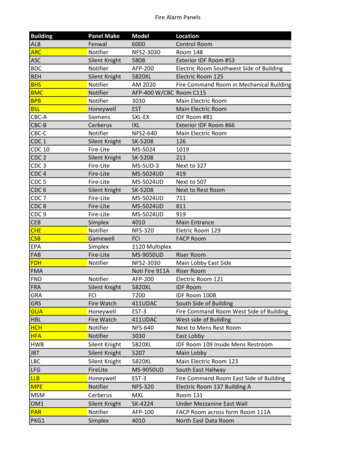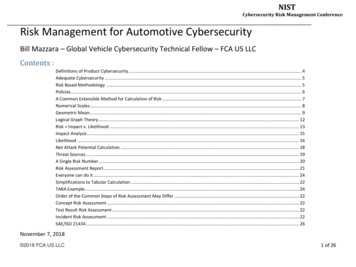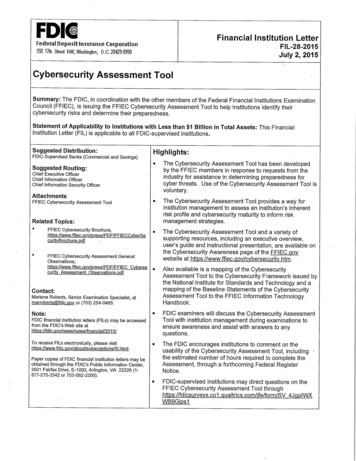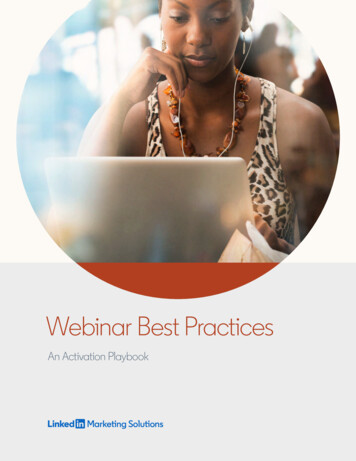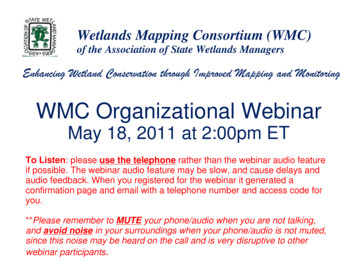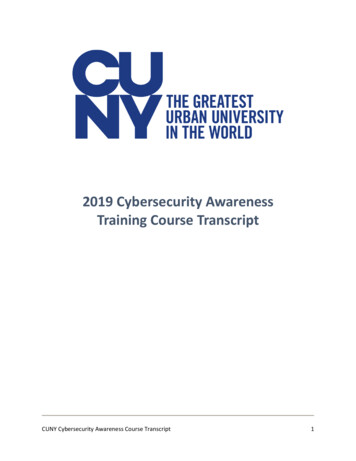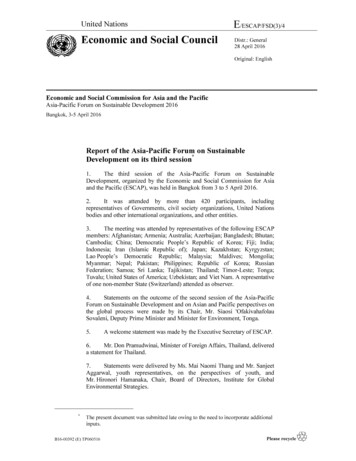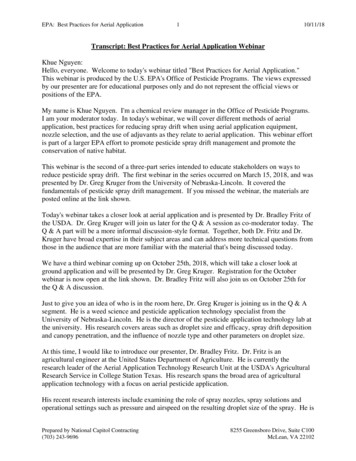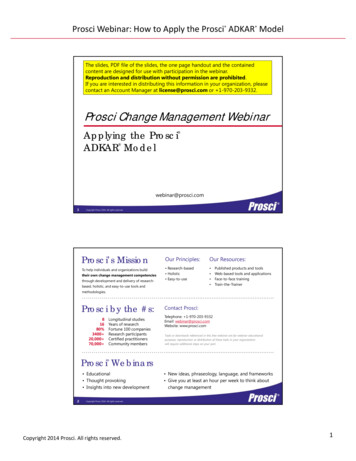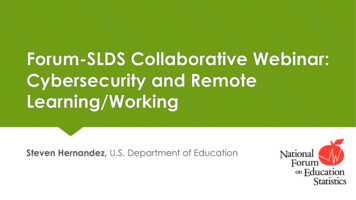
Transcription
Forum-SLDS Collaborative Webinar:Cybersecurity and RemoteLearning/WorkingSteven Hernandez, U.S. Department of Education
Cyber Security: A FederalPerspective during COVID-19U.S. Department of Education2
AgendaIntroductionOverview of the present threatscapeBest practicesFederal resources that can helpQuestions33
IntroductionSteven HernandezMBA, CISSP, CISA, CNSS, CSSLP, SSCP, CAP, ITILChief Information Security Officer (CISO)US Department of EducationPrior Roles:Vice Chairman Board of Directors (ISC)2CISO HHS OIGSenior Official for Privacy, HHS OIG44
COVID-19 Cyber Vigilance Update OCIO has been increasing outreach and alerts to the Department of the evolving security threats and attacksdue to the current COVID-19 situation There has been a significant increase in phishing and other cybercriminal scams targeting a largely at-homeworkforce. Experts are warning that cybercriminals are targeting those who use Zoom, Houseparty, ZohoMeeting and many other commercially free offerings for teleconferencing. Thousands of phishing sites havebeen created to target these providers. Phishing, malicious websites, malware, ransomware, and shadow IT solutions were cited as current topthreats Department users are urged to stay vigilant and continue to report suspected phishing attempts andsuspicious emails through the ED Report Phishing buttonControlled Unclassified Information (CUI)5
COVID-19 Cyber Vigilance UpdateAlert (AA20-099A)COVID-19 Exploited by Malicious Cyber Actors This is a joint alert from the United States Department ofHomeland Security (DHS) Cybersecurity and InfrastructureSecurity Agency (CISA) and the United Kingdom’s National CyberSecurity Centre (NCSC). APT groups and cybercriminals are targeting individuals, small andmedium enterprises, and large organizations with COVID-19-relatedscams and phishing emails. This alert provides an overview ofCOVID-19-related malicious cyber activity and offers practicaladvice that individuals and organizations can follow to reduce therisk of being impacted.6
COVID-19 Cyber Vigilance UpdateAlert (AA20-099A)COVID-19 Exploited by Malicious Cyber Actors Both APT groups and cybercriminals are likely to continue to exploitthe COVID-19 pandemic over the coming weeks and months.Threats observed include:– Phishing, using the subject of coronavirus or COVID-19 as a lure,– Malware distribution, using coronavirus- or COVID-19- themed lures,– Registration of new domain names containing wording related tocoronavirus or COVID-19, and– Attacks against newly—and often rapidly—deployed remote access andteleworking infrastructure.7
COVID-19 Cyber Vigilance UpdateAlert (AA20-099A)COVID-19 Exploited by Malicious Cyber Actors Malicious cyber actors rely on basic social engineering methods toentice a user to carry out a specific action. These actors are takingadvantage of human traits such as curiosity and concern aroundthe coronavirus pandemic in order to persuade potential victims to:– Click on a link or download an app that may lead to a phishing website, orthe downloading of malware, including ransomware. For example, a malicious Android app purports to provide a real-time coronavirusoutbreak tracker but instead attempts to trick the user into providing administrativeaccess to install "CovidLock" ransomware on their device.[1]– Open a file (such as an email attachment) that contains malware. For example, email subject lines contain COVID-19-related phrases such as“Coronavirus Update” or “2019-nCov: Coronavirus outbreak in your city(Emergency)”8
COVID-19 Cyber Vigilance UpdateAlert (AA20-099A)COVID-19 Exploited by Malicious Cyber Actors To create the impression of authenticity, malicious cyber actors may spoof senderinformation in an email to make it appear to come from a trustworthy source, suchas the World Health Organization (WHO) or an individual with “Dr.” in their title. Inseveral examples, actors send phishing emails that contain links to a fake emaillogin page. Other emails purport to be from an organization’s human resources(HR) department and advise the employee to open the attachment. Malicious file attachments containing malware payloads may be named withcoronavirus- or COVID-19-related themes, such as “President discusses budgetsavings due to coronavirus with Cabinet.rtf.”9
SMSPhishing10
SMSPhishing11
COVID-19 Cyber Vigilance Update1. Phishing for credential theftTo further entice the recipient, the websites will often contain COVID-19-related wording within the URL (e.g., “corona-virusbusiness-update,” “covid19-advisory,” or “cov19esupport”). These spoofed pages are designed to look legitimate or accuratelyimpersonate well-known websites. Often the only way to notice malicious intent is through examining the website URL. Insome circumstances, malicious cyber actors specifically customize these spoofed login webpages for the intended victim.If the victim enters their password on the spoofed page, the attackers will be able to access the victim’s online accounts, suchas their email inbox. This access can then be used to acquire personal or sensitive information, or to further disseminatephishing emails, using the victim’s address book.2. Phishing for malware deploymentSeveral threat actors have used COVID-19-related lures to deploy malware. In most cases, actors craft an email that persuadesthe victim to open an attachment or download a malicious file from a linked website. When the victim opens the attachment,the malware is executed, compromising the victim’s device.3. Exploitation of new teleworking infrastructure and ServicesMany organizations have rapidly deployed new networks, including VPNs and related IT infrastructure, to shift their entireworkforce to teleworking. Malicious cyber actors are taking advantage of this mass move to telework by exploiting a variety ofpublicly known vulnerabilities in VPNs and other remote working tools and software. In several examples, CISA and NCSC haveobserved actors scanning for publicly known vulnerabilities in Citrix. Citrix vulnerability, CVE-2019-19781, and its exploitationhave been widely reported since early January 2020. Both CISA[9] and NCSC[10] provide guidance on CVE-2019-19781 andcontinue to investigate multiple instances of this vulnerability's exploitation.12
COVID-19 Cyber Vigilance Update1. Phishing for credential theftTo further entice the recipient, the websites will often contain COVID-19-related wording within the URL (e.g., “corona-virusbusiness-update,” “covid19-advisory,” or “cov19esupport”). These spoofed pages are designed to look legitimate or accuratelyimpersonate well-known websites. Often the only way to notice malicious intent is through examining the website URL. Insome circumstances, malicious cyber actors specifically customize these spoofed login webpages for the intended victim.If the victim enters their password on the spoofed page, the attackers will be able to access the victim’s online accounts, suchas their email inbox. This access can then be used to acquire personal or sensitive information, or to further disseminatephishing emails, using the victim’s address book.2. Phishing for malware deploymentSeveral threat actors have used COVID-19-related lures to deploy malware. In most cases, actors craft an email that persuadesthe victim to open an attachment or download a malicious file from a linked website. When the victim opens the attachment,the malware is executed, compromising the victim’s device.3. Exploitation of new teleworking infrastructure and ServicesMany organizations have rapidly deployed new networks, including VPNs and related IT infrastructure, to shift their entireworkforce to teleworking. Malicious cyber actors are taking advantage of this mass move to telework by exploiting a variety ofpublicly known vulnerabilities in VPNs and other remote working tools and software. In several examples, CISA and NCSC haveobserved actors scanning for publicly known vulnerabilities in Citrix. Citrix vulnerability, CVE-2019-19781, and its exploitationhave been widely reported since early January 2020. Both CISA[9] and NCSC[10] provide guidance on CVE-2019-19781 andcontinue to investigate multiple instances of this vulnerability's exploitation.13
Teleconferencing VulnerabilitiesBeware of watering hole attacks!14
Teleconferencing Vulnerabilities1.Leverage your organization’s approved teleconferencing services1. For Organizers:1. Require a password for entry or use a lobby to only allow known attendees2. For sensitive information consider a list of passwords sent via sms or anotherchannel to the recipients. Remove those who will not confirm their identity3. If the solution supports “closing” or “locking” your conference do so after the start4. Understand how to remove participants if needed5. Ensure you limit your screenshare. Share in this order when possible:1. File2. Application3. Desktop6. If on webcam blur/replace or be aware of your background7. You may want to inform folks if taking screenshots is ok.15
Teleconferencing Vulnerabilities1.Leverage your organization’s approvedteleconferencing services whenever possible1.For Attendees:1.Double check the URL of the meeting you think you areattending2.Make sure your client software is up to date3.Assume everything you share will be recorded and potentiallymade public. This is exceptionally true when joining free/nocost solutions.16
Best Practices for Data Focused Missions Identify Your “Crown Jewels” Least Function Least Privilege De-Identification Retention Have an Actionable Plan in Place Before an Intrusion Occurs Have Appropriate Technology and Services in Place Before An Intrusion Occurs Have Appropriate Authorization in Place to Permit Network Monitoring Ensure Your Legal Counsel is Familiar with Technology and Cyber IncidentManagement to Reduce Response Time During an Incident Ensure Organization Policies Align with Your Cyber Incident Response Plan Engage with Law Enforcement Before an Incident Establish Relationships with Cyber Information Sharing Organizations1717
Best Practices for Data Focused Missions Building the Security in from the start Consider leveraging cloud SaaS as much as possible Review terms and SLA Data Portability Leverage FedRAMP systems May not always be able to use GSA contracts Federal Government Level of Security You are still accountable for control configuration State and local government representatives are encouraged tocontact any FedRAMP Authorized CSP directly to determine theirsecurity package specifications. EDUCAUSE Higher Education Cloud Assessment Tool her-education-cloud-vendor-assessment-tool1818
Helpful Federal Resources US Department of Education https://studentprivacy.ed.gov/ https://nces.ed.gov/programs/ptac/ FBI Internet Crime Compliant Center (https://www.ic3.gov/default.aspx)Local Field Offices (Establish a relationship sooner than s Infraguard (https://www.infragard.org/) MS-ISAC (https://www.cisecurity.org/ms-isac/) Connects back to the US Department of Homeland Security Secret Service Field Offices (http://www.secretservice.gov/field offices.shtml ) Electronic Crimes Task Forces (ECTFs) (http://www.secretservice.gov/ectf.shtml )1919
Helpful Federal Resources DOJ Best Practices for Victim Response and Reporting of Cyber Incidents eeches/attachments/2015/04/29/criminal division guidance on best practices for victim response and reporting cyber incidents.pdf NSA's Top Ten Cybersecurity Mitigation Strategies egies.cfm United States General Services Administration FedRAMP Program https://www.fedramp.gov/training/2020
Helpful Federal ResourcesCyber Infrastructure and Security AgencyRequest information about the service(s) you are interested in by emailing ncats info@hq.dhs.gov.All services are available at no cost to federal agencies, state and local governments, critical infrastructure, and privateorganizations generally.Cyber Hygiene: Vulnerability Scanning helps secure your internet-facing systems from weak configuration andknown vulnerabilities, and encourages the adoption of modern security best practices. DHS performs regularnetwork and vulnerability scans and delivers a weekly report for your action. Once initiated, this service ismostly automated and requires little direct interaction. After we receive the required paperwork for CyberHygiene, our scans will start within 72 hours and you’ll begin receiving reports within two weeks.Cyber Hygiene Sample ReportA Phishing Campaign Assessment (PCA) measures your team’s propensity to click on email phishing lures.Phishing is commonly used as a means to breach an organization’s network. The assessment occurs over a 6week period, and the results can be used to provide guidance for anti-phishing training and awareness.Phishing Campaign Assessment (PCA) Sample Report2121
THANKS!!!!Questions?Contact me:Steven G HernandezSteven.Hernandez@ed.gov2222
Thank You Steven!The forthcoming Forum Guide to Cybersecurity will be published onthe Forum website at https://nces.ed.gov/forum/.
observed actors scanning for publicly known vulnerabilities in Citrix. Citrix vulnerability, CVE-2019-19781, and its exploitation have been widely reported since early January 2020. Both CISA [9] and NCSC[10] provide guidance on CVE-2019-19781 and continue to investigate multiple instances of this vulnerability's exploitation. 12
